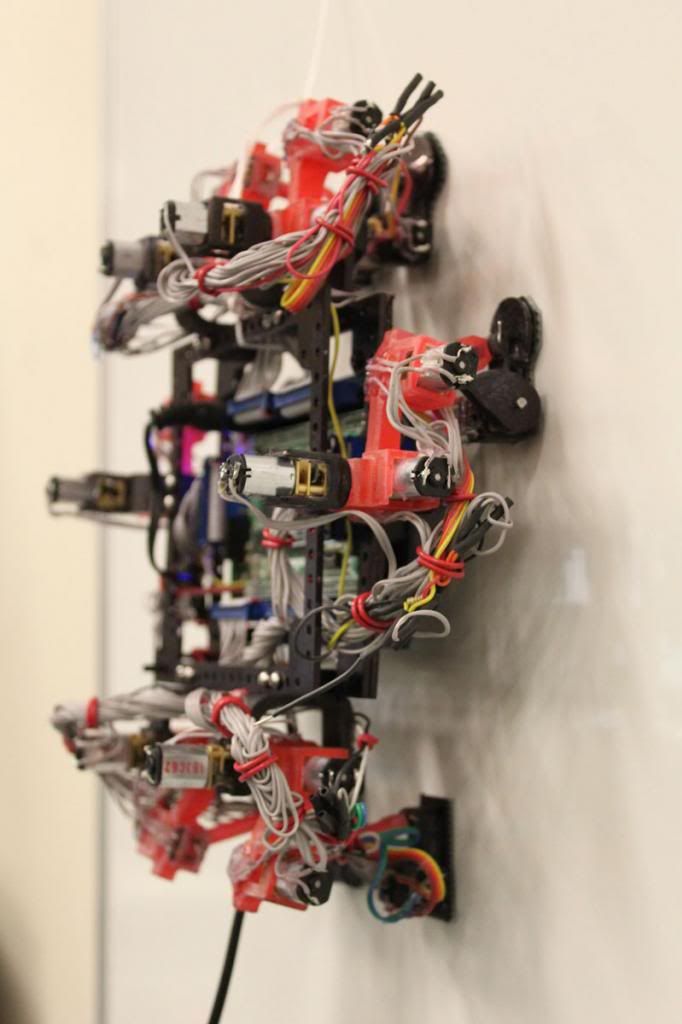Kiwithrottlejockey
Admin Staff
XNC2 GOD

Posts: 32249
Having fun in the hills!
|
 |
« on: January 04, 2014, 01:15:38 pm » |
|
From the Los Angeles Times....Space geckos? Sticky-footed robots could climb future spacecraftBy AMINA KHAN | 3:54PM PST - Thursday, January 02, 2014 A six-legged climbing robot can go from vertical to horizontal surfaces. It clings to walls using a gecko-inspired A six-legged climbing robot can go from vertical to horizontal surfaces. It clings to walls using a gecko-inspired
dry adhesive technology. — Photo: Simon Fraser University.GECKO'S STICKY FEET seem to let the little climbing lizards crawl wherever they want. Now researchers have used the gecko feet’s trade secrets to let robots use that climbing power in space.
The idea, which received backing from the European Space Agency, mimics the pads of the gecko’s feet to allow small robots to climb up the hulls of larger spacecraft to maintain and even repair them. Such repair bots could extend the lives of expensive spacecraft, save them from sudden and untimely deaths, and perhaps one day minimize risky spacewalks for future astronauts.
Gecko feet use a "dry adhesive" technique to cling to walls. This doesn’t rely on sticky glues, but on bunches of exceedingly tiny hairs on their feet with ends just 100 to 200 nanometers across — about the size of individual bacteria. These structures are so small that they take advantage of the van der Waals force, where atoms in close contact — in this case, the gecko's foot and the surface it’s stepping on — are attracted to each other.
The van der Waals force only works on very small scales, when atoms are in very, very close contact — and most smooth surfaces are actually quite rough on the micro and nanoscales, said Carlo Menon, an engineer and professor at Simon Fraser University in Canada who is working on the climbing robots. The gecko’s tiny foot hairs fill those gaps in, maximizing the contact area between foot and wall, and allowing the van der Waals force to do its work.
This kind of sticking power would be useful in space, Menon said.
"It’s a fundamental problem," Menon said. "In space there are not many options if you want to adhere to a surface and detach multiple times in a vacuum."
The researchers decided to use the technique because it’s a far better option than using traditional adhesives in space. Wet glues — the kind that make scotch tape sticky — lose their stick as they’re repeatedly lifted and then reapplied, and could also give off fumes that damage sensitive electronic equipment.
Using magnets to stick to a metal spacecraft wouldn’t work either, as they don’t stick to composites and the magnetic fields they generate could affect scientific instrument readings. Velcro only works if the other surface also has Velcro, and broken-off hook fragments could also contaminate the electronic equipment.
A gecko-based solution would have no such drawbacks, so the scientists used a polymer to create hairlike structures on the adhesive. They're not as small as those keratin-based structures on the gecko feet — about 100 times larger — but made of softer stuff that could slightly mold onto a rough surface and improve the surface contact. They tested the adhesive in a vacuum and it held up well, Menon said.
Using the adhesive, he and his team have created two different robot designs — a rolling, tank-like system and a six-legged walker named Abigaille. Both come with their own set of advantages, he said.
"Each of them has pros and cons," Menon said. "If you want to have more dexterity, you go with the leg. If you are more concerned about power consumption, probably the tank is a better choice."http://www.latimes.com/science/sciencenow/la-sci-sn-gecko-feet-robot-space-spacecraft-repair-esa-20140102,0,4133716.story
|
If you aren't living life on the edge, you're taking up too much space!   |
|
|
|


|
|
|
|